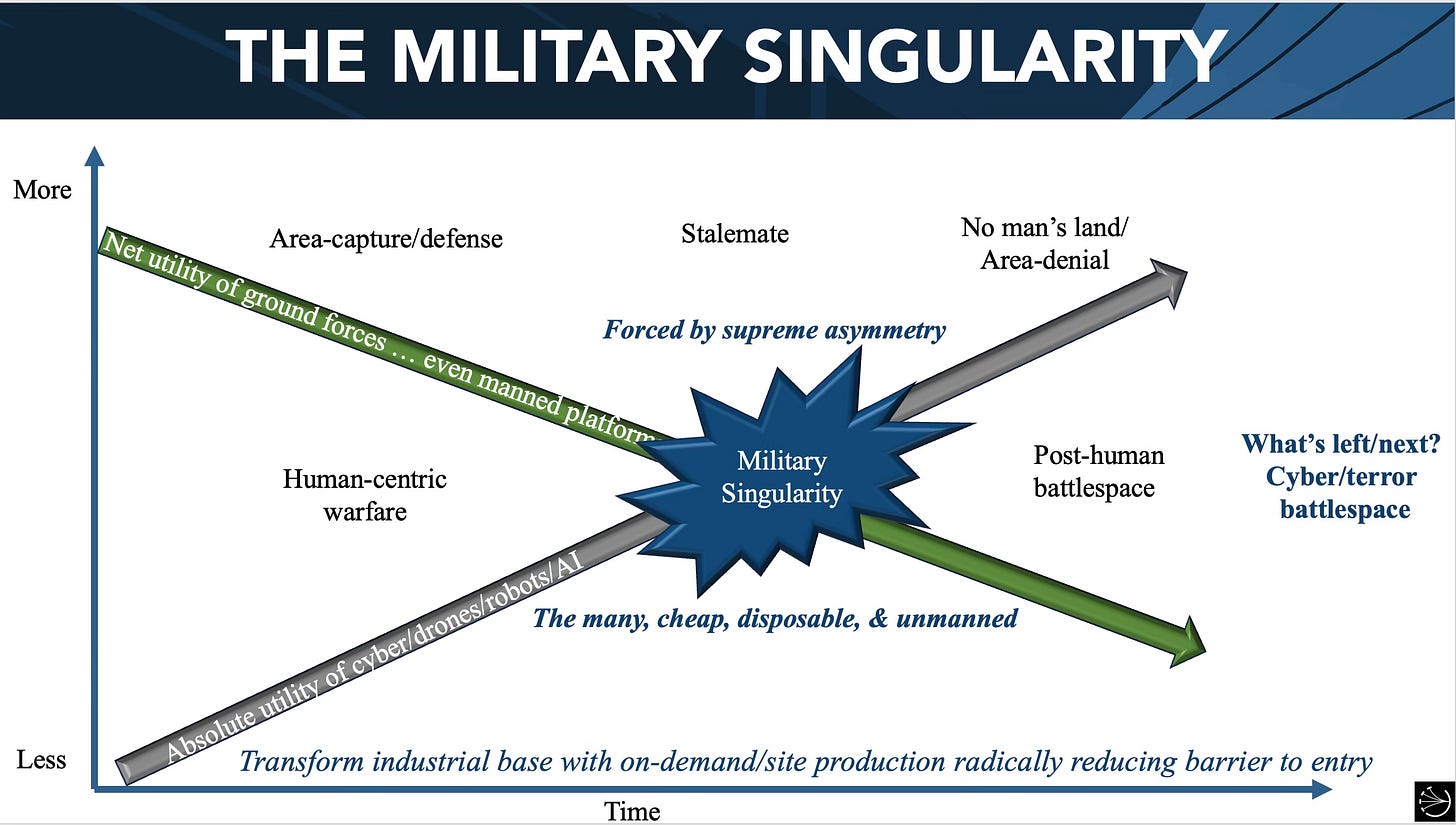During my three-year-stint as a visiting-but-remote strategist at the Beijing-based Knowfar Institute for Strategic & Defence Studies, I was asked to pen something on rising powers and their tendencies for initiating “proof of concept” wars that announce to the world, I’m here and I’m powerful and I’m not going away!
So I did and you can read it here:
A Splendid Little Report
Detail from Charge of the 24th and 25th Colored Infantry, July 2nd 1898 depicting the Battle of San Juan Hill. 1899 lithograph by Chicago printers Kurz and Allison. Online. Converted to JPEG and cropped. Public domain as per Bridgeman Art Library v. Corel Corp.
The obvious model (and the one the institute’s leadership wanted explored) was America’s war against Spain in 1898 (a one-year war!). So, I developed a model of signposts/avenues/rationales indicative of such a tempting conflict, as in, if you see this and that from the Chinese, you might be looking at another “splendid little war,” as that conflict was then dubbed by Secretary of State John Hay.
Then I went through each item of my list/model and gave the China/Taiwan comparison.
In the end, my advice to China was to pass on the scenario, deeming it essentially unwinnable in a clear and fast and outright sense and thus unlikely to produce the outcome desired (i.e., successful signaling of China’s arrival as a military superpower). Just in the practical sense, the odds of a military achieving such a complex and arduous campaign when it hasn’t fought an actual war in decades … well, history just says that’s not likely.
But the bigger problems I had with the scenario, from China’s side, revolved around its domestic situation — namely, the party’s standing in the event of a draw or defeat, both of which struck me as more likely than a brilliant win.
My short answer in the report: when you’re a single-party state, there is no relief valve called “throw the bums out of office.” In a democracy like the US, we can just vote in the opposition, have them declare — not “my bad” but —“their bad,” and take the loss at virtually no cost to domestic tranquility. In the Global War on Terror (GWOT), George W. Bush went too far — as far as the public was concerned — and Obama stepped in to reel the whole thing back over time and extending that strategic re-adjustment through three other nation-building-at-home, follow-on presidencies (i.e., Trump, Biden, Trump 2.0).
We were a military superpower going in the GWOT, and we remain one coming out of the GWOT. That is our super power: we can lose and yet remain preeminent in the system. Can you think of any other power that is today so capable?
Me? I’d have to go back to the British Empire at its Victorian Age peak to locate that sort of strategic certitude.
China’s Communist Party cannot risk something similar — just too dangerous, too uncertain, too hard to control. The CCP is all about control and thus unwilling to engage in risky behavior. Better to “nibble like a silkworm” and incrementally encroach — a pattern of behavior the Chinese greatly prefer.
There is no chance of a “surprise” Chinese invasion of Taiwan — it is the Y2K of “splendid little wars” — as in, about as anti-climactic as you can get.
Instead of risking so much of China’s “rise” on that one scenario, my advice, in my Knowfar report, was to Teddy Roosevelt the whole thing by speaking softly and carrying that big stick.
Why? China’s rise came with a term limit of sorts — mostly demographic in nature. Simply put, China is aging at a rate we’ve never seen before — something like three-times as fast as the US in terms of rising median age.
Time is most definitely NOT on China’s side, so the answer must be for Beijing to secure a mini-world-order of its preference while the getting is good, and right now, the getting is VERY good, SUPREMELY good, I-can’t-believe-how-sweet-it-is good!
The US is in the middle of a multi-decade strategic retreat from overseas obligations, largely driven by their ruinous costs during an era of globalization that now features fierce economic competition that, in turn, demands significant fiscal investments for America to adequately compete. It’s not just enough to fund the Military Industrial Complex and wait on the trickle down, because, in this century and this iteration of globalization, our margin of technological superiority has been severely degraded.
Our natural response to that frightening reality is to double-down on military spending — the tried and true Cold War approach to “winning.”
The problem, of course, is that such a “win” becomes less meaningfully pursued as the Singularity looms. We’ve already witnessed what the Military Singularity has wrought on the Ukrainian battlefields — theaters of operation that have grown far too dangerous for either side to risk troops except in admittedly suicidal assaults.
We’ve seen the US Military change in response: gone are the fantastic ambitions for platform-centric naval warfare and Marines invading island chains in a repeat of WWII. Instead, we are now to meet the Chinese invasion with a “drone hellscape.”
What happens beyond that?
As evidenced by Russia-v-Ukraine, what happens after repelling (or just degrading) the invasion is that both sides make a wasteland of it and call it “war.”
Except the war never ends and barely budges, yielding a no-man’s land that neither side can win but both sides can most definitely deny to the other.
At that point, one just keeps throwing drones into combat until one runs out — which will be never.
As I have argued here before, the Military Singularity — or the radical transition to a post-human battlefield — essentially kills great-power conventional war in the same manner that Mutually Assured Destruction (MAD) does to strategic great-power war. It caps it with a foreknowledge of the default outcome, which is, in both instances, pointless destruction yielding so strategic gain.
Has either China or the US learned this lesson yet? No.
It took the Cuban Missile Crisis to truly birth MAD-awareness in both Moscow and Washington, and it will likely take more than Russia-v-Ukraine to birth its equivalent in conventional great-power warfare.
But the signs are appearing and accumulating:
FOREIGN AFFAIRS: The Age of Forever Wars
The inestimable Lawrence Freedman’s judgment? Best to avoid these forever wars.
And yet, America’s foreign policy establishment and military industrial complex is full of experts and decision makers convinced that America must do whatever is necessary to prevent China’s acquisition of Taiwan because that would decide the superpower competition this century!
I mean, it would, right? It would be for “all the marbles” and whatnot, to be sure, like when America “lost” Vietnam and thus lost the Cold War completely … except that wasn’t the case.
Why?
All the military stuff is about killing time while the real competition is over which model/version of mini-globalization actually wins in the end. America’s Free World won the Cold War economically — not militarily. And, if China is going to beat us this time around, it won’t be through military means but through superior economic networking.
China’s “SysAdmin” force is winning all over the planet right now. It is known as the Belt and Road Initiative.
Meanwhile, our White House fights a tariff war with the entire world to instantly reposition us as a dominant manufacturing power because … well, just because and shut your mouth, dumbass! If you can’t see how Trump is playing 4D chess while the poor Chinese peasants don’t know their rear-ends from their elbows, then you clearly don’t understand the Great Man theory of history (see Stalin, Hitler, Mao, Putin, Trump)
So, while we gear up for a lengthy Cold War peace-through-strength military competition with China, the Chinese are leaping ahead on renewable energy and AI and other less important stuff.
Listen to this White House and its strategic rationales: we need to own entire supply chains on EVERYTHING of military value — or else! And, if that means we need to turn the free-trading US into a 21st century version of the Kim Dynasty’s Hermit Kingdom, then so be it!
We are at the beginning of a severe learning curve. In our relationship and competition with China, our trade interdependency is more profound than we realize (but we’ll learn very soon), and that’s before we start exploring our far more profound financial and even fiscal interdependency — none of which existed between the USSR and the US back during the Cold War.
Compared to these economic realities, and the ongoing nature of our competition to wire up the Global South so we can control all that Big Data so we can grow our AI faster than the other side … compared to all that, the Taiwan scenario is meaningless — as in, it will prove nothing and win nothing for either side.
The idea that we should sabotage the global trade order so as to somehow deny China access to — much less dominance over — supply chains of strategic importance … honestly, that is just NUTS! It is entirely unrealistic and forces a choice upon the world that that world may well answer not in our favor but in Beijing’s favor.
Why? Who seems the steadier model right now? Who seems the more fair arbiter on trade? Whom can you trust?
But yes, by all means, let’s pour billions more into defense while crippling research and development in biotech and AI and other lesser pursuits. Let’s pretend that by denying Taiwan to China that we are clearly “winning” this “Cold War.” Let’s pretend that “all the marbles” are located off China’s coast.
The one glimmer of hope here?
By pursuing a disastrous tariff war with China — one on one, we are waging a proxy “splendid little war,” that, per Trump is “easy” to win.
That splendid little war will serve as proxy for the real one, which would naturally collapse not over the military stalemate achieved (see, drone hellscape) but over the economic damage it would wreak.
We are learning the contours of that latter effect — absent the initiating war, thanks to Trump’s mania for this fight.
For one of many early indicators, see:
NYT: China Halts Critical Exports as Trade War Intensifies; Beijing has suspended exports of certain rare earth minerals and magnets that are crucial for the world’s car, semiconductor and aerospace industries.
Let’s hope the right lessons are learned, because they’re going to be fierce.








